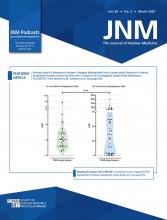Discussions with leaders: David Mankoff talked with mother and daughter Martine Piccart and Géraldine Gebhart about their careers as leaders in medical oncology and molecular imaging.
Page 337
Sequencing of SSR-targeted therapies: Strosberg and colleagues examine evidence supporting use of somatostatin receptor–targeted treatments within the larger landscape of neuroendocrine tumor therapy and offer insights into patient selection, benefits/risks, and treatment sequencing.
Page 340
Precision oncology in breast cancer: Jacene and colleagues provide an educational overview of current treatment paradigms and the expanding role of molecular imaging as a precision medicine biomarker for advanced breast cancer.
Page 349
Acute GvHD molecular imaging: Bernardi and colleagues summarize current molecular imaging approaches for noninvasive detection of acute graft-versus-host disease, with a specific focus on PET, its integration into the clinical setting, and associated challenges.
Page 357
Rethinking RNT dosimetry: Strosberg and colleagues offer perspective on the effectiveness of extrapolating external-beam–defined normal organ constraints to radionuclide therapy dosimetry and call for evidence-based strategies to improve personalized treatment.
Page 362
68Ga-FAPI PET/CT accuracy in HNCUP: Gu and colleagues investigate the potential of 68Ga-labeled fibroblast activation protein inhibitor PET/CT compared with that of 18F-FDG PET/CT for detection of primary tumors in patients with head and neck cancer of unknown primary.
Page 365
68Ga-FAPI vs. 18F-FDG for oncologic PET: Hirmas and colleagues report on a head-to-head comparison of 68Ga-labeled fibroblast activation protein inhibitor and 18F-labeled FDG PET across a range of tumor entities.
Page 372
Imaging intraprostatic radiorecurrent disease: Light and colleagues detail the results of a study of 68Ga-PSMA-11 PET/CT and multiparametric MRI in patients referred for radiorecurrence of prostate cancer.
Page 379
Site-specific 89Zr-pertuzumab: Yeh and colleagues describe a first-in-humans PET study in human epidermal growth factor receptor 2–positive breast cancer, looking at the safety, biodistribution, and dosimetrics of this site-specifically labeled radioimmunoconjugate.
Page 386
68Ga-FAPI-LM3 PET in NPC: Zhao and colleagues design and synthesize a heterobivalent fibroblast activation protein inhibitor molecule radiolabeled with 68Ga and evaluate its effectiveness in tumor xenografts and in patients with nasopharyngeal carcinoma.
Page 394
225Ac-nimotuzumab in colon cancer models: Tikum and colleagues assess the effectiveness of this anti–epidermal growth factor receptor antibody radioimmunoconjugate in both in vitro and in vivo colorectal cancer studies.
Page 402
Posttreatment SPECT/CT and PRRT: Yadav and colleagues determine the impact of qualitative posttreatment imaging on management of patients with advanced neuroendocrine tumors undergoing 177Lu-DOTATATE peptide receptor radionuclide therapy.
Page 409
[18F]FET-βAG-TOCA PET/CT in NET detection: Dubash and colleagues report on a prospective, noninferiority comparison of [18F]FET-βAG-TOCA PET/CT with [68Ga]Ga-DOTA-peptide PET/CT in patients with neuroendocrine tumors, highlighting the advantages of an 18F-labeled tracer.
Page 416
PSMA-radioguided pelvic LN dissection: Schilham and colleagues evaluate the safety and feasibility of 111In-PSMA–radioguided surgery in primary cancer patients with at least 1 suggestive lymph node on preoperative 18F-PSMA PET/CT.
Page 423
Perspective on DETECT trial: Maurer and colleagues offer commentary on a report in this issue of JNM on a prospective clinical trial of PSMA-radioguided surgery in primary prostate cancer.
Page 430
177Lu-rhPSMA-10.1 in prostate cancer: Dierks and colleagues detail efficacy and safety findings from dosimetry studies on this 177Lu-labeled agent in a small group of patients with PSMA-positive metastatic prostate cancer.
Page 432
177Lu-PSMA international survey: Farolfi and colleagues report on responses to a survey documenting operational differences and similarities among 177Lu-PSMA treatment centers and comment on the need for standardization/harmonization among theranostic sites.
Page 438
DAT SPECT with multipinhole collimators: Buchert and colleagues explore the potential to reduce scan duration in dopamine transporter SPECT when using a second-generation multiple-pinhole collimator designed for brain SPECT, with improved count sensitivity and spatial resolution.
Page 446
Longitudinal [18F]PI-2620 PET in AD: Oh and colleagues use this second-generation tau PET tracer to investigate changes over time in cortical tau accumulation and associated cognitive decline in early- and late-onset Alzheimer disease.
Page 453
18F-SynVesT-2 brain kinetics: Drake and colleagues evaluate the fast brain kinetics, test–retest reproducibility, and extent of specific binding of this recently developed synaptic vesicle glycoprotein 2A PET ligand.
Page 462
Triggered seizures for ictal SPECT: Barlatey and colleagues use 99mTc-HMPAO SPECT to image planned seizures triggered by direct stimulation of epileptic networks via stereotactic electroencephalography electrodes in patients with left temporal epilepsy.
Page 470
Mapping fructolysis with [18F]4-FDF: Kirby and colleagues generate a radiodeoxyfluorinated fructose analog, evaluate its metabolic flux in vitro, and assess preclinical PET imaging for mapping fructose metabolism in models of cancer and systemic inflammation.
Page 475
161Tb- and 177Lu-Labeled GRPR antagonists: Holzleitner and colleagues compare preclinical performances of the gastrin-releasing peptide receptor antagonists RM2 and AMTG, each labeled with 177Lu and 161Tb, to elucidate potential benefits of the Auger-electron–emitting radionuclide 161Tb.
Page 481
Task-based evaluation segmentation: Liu and colleagues investigate whether evaluating PET segmentation algorithms based on task-agnostic figures of merit yields interpretations consistent with evaluation on clinically relevant quantitative tasks.
Page 485
CCK2R-directed PET in MTC: Viering and colleagues provide an illustrated case report on postoperative [68Ga]Ga-DOTA-CCK-66 PET/CT in a patient with medullary thyroid cancer to assess eligibility for cholecystokinin-2 receptor–directed radioligand therapy.
Page 493
- © 2024 by the Society of Nuclear Medicine and Molecular Imaging.







